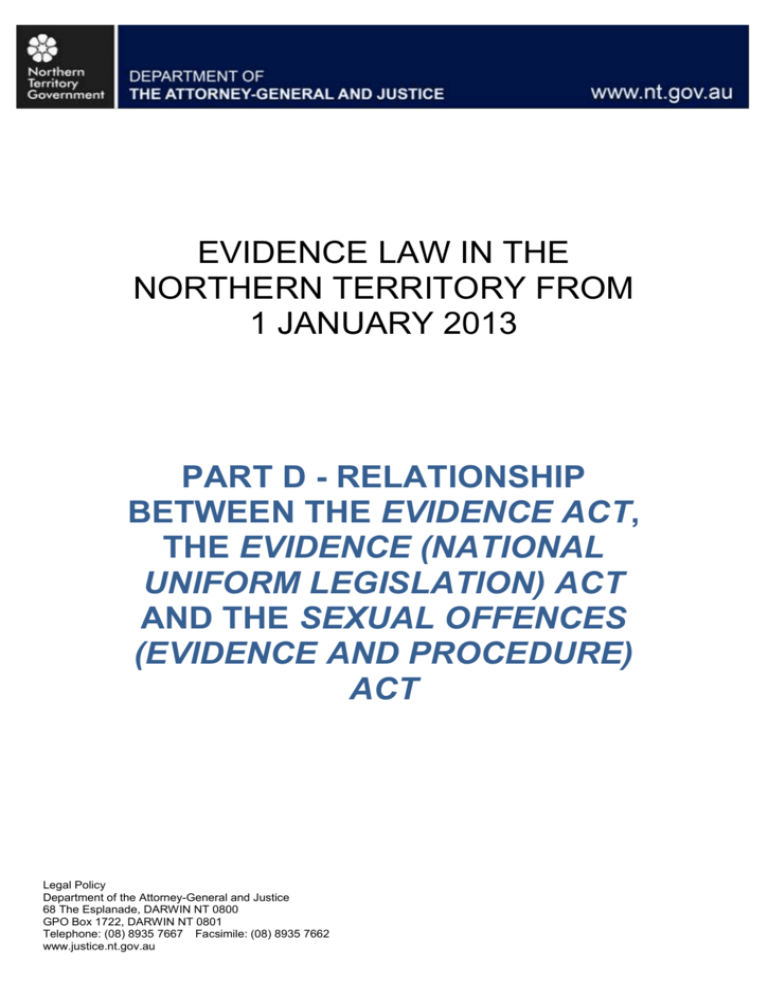
EVIDENCE LAW IN THE
NORTHERN TERRITORY FROM
1 JANUARY 2013
PART D - RELATIONSHIP
BETWEEN THE EVIDENCE ACT,
THE EVIDENCE (NATIONAL
UNIFORM LEGISLATION) ACT
AND THE SEXUAL OFFENCES
(EVIDENCE AND PROCEDURE)
ACT
Legal Policy
Department of the Attorney-General and Justice
68 The Esplanade, DARWIN NT 0800
GPO Box 1722, DARWIN NT 0801
Telephone: (08) 8935 7667 Facsimile: (08) 8935 7662
www.justice.nt.gov.au
Part D – Relationship between the Evidence Act, the Evidence (National Uniform Legislation) Act and
the Sexual Offences (Evidence and Procedure) Act
Contents
Summary ................................................................................................................... 3
Evidence: Sexual offence laws .................................................................................. 3
Relationship with the Uniform Evidence Act .............................................................. 4
2
Part D – Relationship between the Evidence Act, the Evidence (National Uniform Legislation) Act and
the Sexual Offences (Evidence and Procedure) Act
Summary
The Evidence (National Uniform Legislation) Act (the “uniform Evidence Act”)
does not affect the operation of the Sexual Offences (Evidence and
Procedure) Act. The uniform Evidence Act does not make admissible
evidence that is inadmissible under the Sexual Offences (Evidence and
Procedure) Act.
Previously, evidence that was not made inadmissible under the sexual
offences laws, may have been inadmissible under common law principles.
Evidence that is not made inadmissible under the sexual offences laws, may
now be inadmissible under the common law, or under the uniform Evidence
Act, or may be regulated by the uniform Evidence Act. It may still be possible
to find common law rules applying to the reception of evidence, because the
uniform Evidence Act is not a code.
Evidence: Sexual offence laws
All states, the ACT and the Northern Territory have laws which specifically
deal with evidence in criminal proceedings where someone is charged with a
sexual offence. These laws regulate the examination of witnesses and the
adducing and admission of evidence of witnesses’ sexual history.1
In the NT, these laws:
prohibit the admission of evidence of a complainant’s sexual reputation,
except with the leave of the court, if the court is satisfied that the
evidence has substantial relevance to the facts in issue;
prevent the use of sexual history evidence to establish the complainant
as a ‘type’ of person who is more likely to consent to sexual activity,
except with the leave of the court, if the court is satisfied that the
evidence has substantial relevance to the facts in issue; and
exclude the use of a complainant’s sexual history as an indicator of the
complainant’s truthfulness.
1
Criminal Procedure Act 1986 (NSW) s 293; Evidence Act 2001 (Tas) s 194M; Evidence
(Miscellaneous Provisions) Act 1991 (ACT) ss 48–53. Evidence Act 1929 (SA) s 34I; Evidence Act
1958 (Vic) s 37A; Criminal Law (Sexual Offences) Act 1978 (Qld); Evidence Act 1906 (WA) ss 36A–
36BC; Sexual Offences (Evidence and Procedure) Act 1983 (NT)
3
Part D – Relationship between the Evidence Act, the Evidence (National Uniform Legislation) Act and
the Sexual Offences (Evidence and Procedure) Act
Relationship with the Uniform Evidence Act
The uniform Evidence Act does not affect the operation of the Sexual
Offences (Evidence and Procedure) Act (refer section 8 of the Evidence
(National Uniform Legislation) Act). The uniform Evidence Act does not
make admissible evidence that is inadmissible under the Sexual
Offences (Evidence and Procedure) Act.
Evidence of sexual reputation or experience may be inadmissible under the
Sexual Offences (Evidence and Procedure) Act, the uniform Evidence Act, or
both. The ALRC described the situation as follows:
For example, leaving aside the operation of rape shield laws, where
evidence of a complainant’s sexual reputation or experience is sought to
be adduced as relevant to the complainant’s credibility, it may be
excluded under s 102 of the uniform Evidence Acts unless it is relevant
for another purpose or falls within one of the exceptions to the credibility
rule.
Evidence of a complainant’s sexual reputation or sexual experience may
be admissible under the exception to the credibility rule provided by
s 103 of the uniform Evidence Act. This section provides that the
credibility rule does not apply to evidence adduced in cross-examination
of a witness (including the complainant in a sexual offence case) if the
evidence has substantial probative value. However, the evidence may
still be ruled inadmissible under rape shield laws....2
However, evidence that is not made inadmissible under the Sexual Offences
(Evidence and Procedure) Act, may be inadmissible under common law
principles, or the uniform Evidence Act, or it may be regulated by the uniform
Evidence Act. For example:
In some circumstances, evidence of a complainant’s sexual reputation or
experience may be subject to the tendency rule. …[Section] 97 of the
uniform Evidence Acts provides that evidence of character, reputation,
conduct or a tendency is not admissible to prove a person’s tendency to
act in a particular way or have a particular state of mind, unless the court
thinks that the evidence would have significant probative value.3
… evidence about prior consensual sexual activity involving the
complainant and the accused may be admissible under exceptions in the
rape shield laws, but still constitutes tendency evidence for the purposes
of s 97 of the uniform Evidence Acts. If so, in order to be admissible,
notice has to be given to the other party and the evidence must have
significant probative value.
2
Para 20.23 and 20.24 Uniform Evidence Law (ALRC Report 102) Published 13 February
2006. Last modified 24 August 2010. Web: ALRC Report.
3
Para 20.25.
4
Part D – Relationship between the Evidence Act, the Evidence (National Uniform Legislation) Act and
the Sexual Offences (Evidence and Procedure) Act
5








